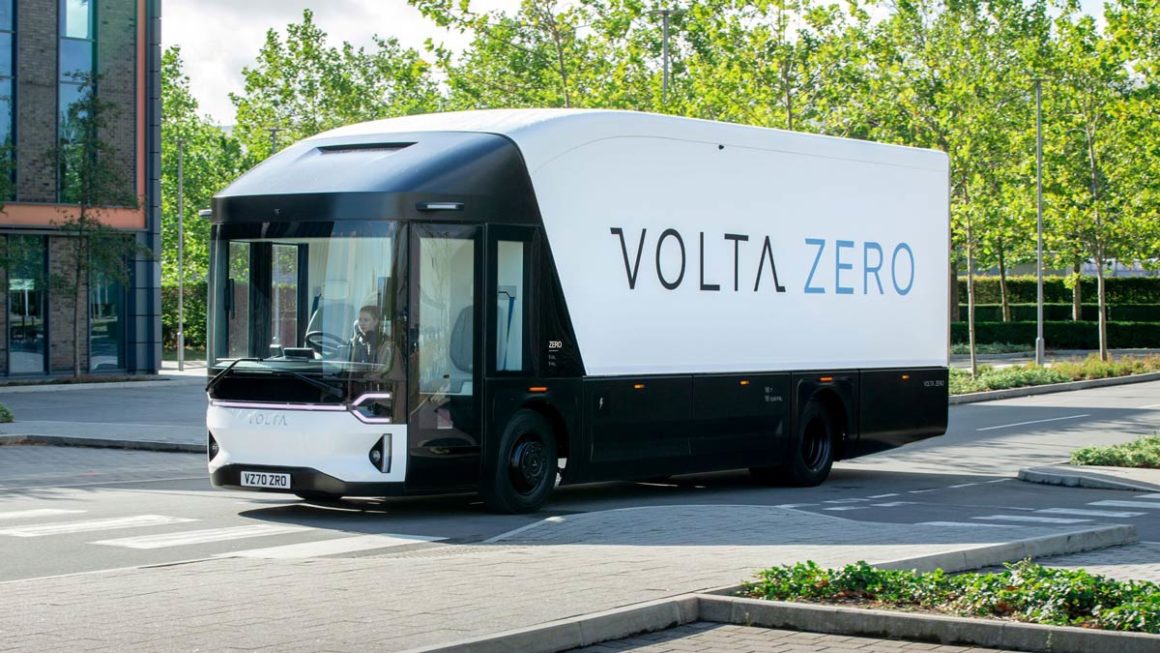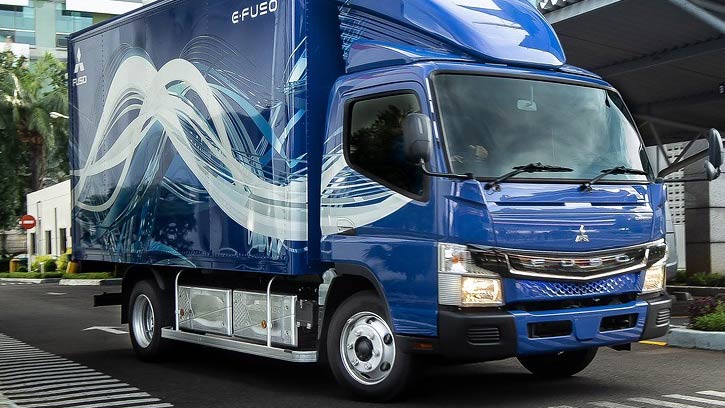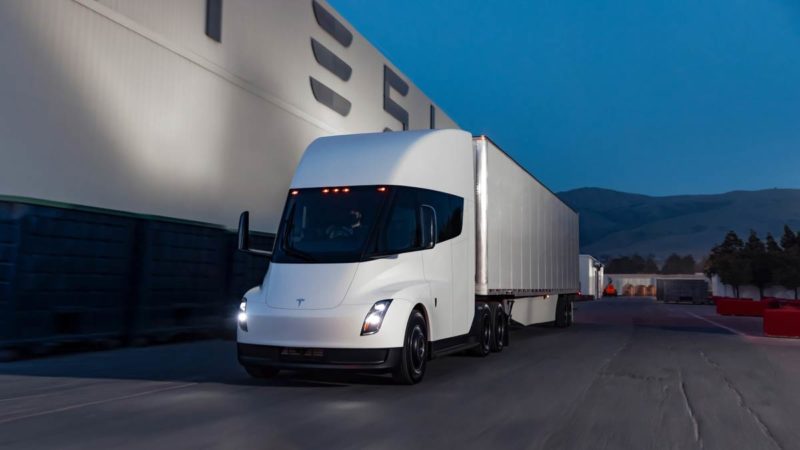Almost four years ago now, I summed up an article on electric trucks here at The Driven by writing:
“…. electrification of the trucking fleet may currently be a bit behind that of the passenger vehicle fleet – but when it begins in around 2021, the change-over is likely to happen at a much faster rate due to both the push factors of diesel pollution and noise bans being overcome, as well as the pull factor of increased profitability for EV truck owners”.
Whilst Tesla may not have come through in its promise to start production of the electric Semi in 2019 (or 2020, or 2021 …) they did finally open the order books this April for 2023 deliveries.
In the meantime, however, Tesla’s competitors have not only kept closer to their development timelines; more have since jumped on board in readiness for the electric truck revolution.
When Tesla do finally release their electric Semi, it will not be the first mover in an empty market like was in the passenger car arena: rather it will be into a busy and growing market of battery electric trucks of all shapes and sizes.

Electric truck developments 2018-2022
First-up, the Freightliner e-Cascadia I described then has finished its trials and is now available to order – with series production to begin later this year.
Its specifications are not as spectacular as the Tesla (more on that later), but Daimler (which owns Freightliner) has confirmed the initially announced specs under real-world conditions.
Freightliner has also stolen the march on Tesla by announcing it will build a US network of critical freight route CCS plug 350kW commercial use chargers, beginning in 2023. (Tesla have yet to even specify the plug type or charge rate of their ‘Megacharger’ truck chargers).

Early movers in the EV truck industry
Volvo has now moved well down the track with an expanding range of EV trucks. Back in 2018 I reported they were developing the 16t FL Electric for release in 2019. Now it has six models of BEV truck available (albeit in limited numbers) ranging from 16t to 37t.
Daimler’s eM2 is also now available to order with formal sales to begin late this year. The Mercedes e-Actros is also now available to purchase. In fact, as can be seen from the table below, the number of EV trucks available or about to come has grown significantly since I wrote about them in 2018.

Also since 2018, several other major truck manufacturers are reported to have begun their own EV transitions. These include BYD, Kenworth and Cummins – however, they are not far enough down the track to include actual models with detailed specifications in the table.
In addition, several start-ups trying to break into the EV truck market. One is US company Bollinger, which is planning to build rigid trucks in the 10 to 26 tonne gross range.
Another is Europe based Volta with a range of innovative delivery vans. Volta is currently expected to begin deliveries late this year or early next. Rivian too has just begun production of the first of a 100,000 order of full electric delivery vans by Amazon (the Rivian EDV).

Australian electric truck maker Janus Electric
As reported recently here at TheDriven, Janus has developed a conversion system for existing prime movers that incorporates an easily swappable battery.
Currently, the Janus battery options provide around 400 to 600 km of range – with plans to build battery swap points on major trucking routes. These battery swaps would then enable the sort of fast refuelling turn-arounds that current battery tech cannot (yet) provide. (They claim around four minutes for a battery swap as compared to 20 min for a diesel truck).
As for the cost savings of switching to electric: Janus estimate that one of their electric-powered prime movers will cost 33c per kilometre to run, compared to 96c per kilometre for diesel.

Table 1: Current and coming EV trucks from around the world.
| Model | GCWa and/or
(payload) |
Range (km) | Battery size/s
(kWh) |
Charge plug | AC/DC charge rates | Available?
(and where) |
| Daimler/Freightliner | ||||||
| e-Cascadia | 37t (27) | 400b | 210, 315, 475 | CCS | TBC | Q4 2022, USA |
| eM2 | 12 – 15t | 370 | 315 | CCS | TBC | Q4 2022, USA |
| Thomas Built Buses | (86 (small) people)e | 216 | 226 | CCS | 19.2/90 | Now, USA |
| Mercedes | ||||||
| e-Actros | 19 or 27t (10.6 or 17.6) | 400b | 336, 448 | CCS | 22/160 | Now, Europe |
| Volvo | ||||||
| FH, FM, FMX series | Up to 44t | 300b | 180 – 540 | CCS | 43/250 | Limited, Europe, USA |
| FL series | Up to 16.7t | 200b | 200 – 395 | CCS | 22/150 | Limited, Europe, USA |
| VNR series | 15 – 37t | 280/400c | 375, 565 | CCS | 43/250 | Limited, Europe, USA |
| MAN | ||||||
| EGTM | 26t | 190d | 185 | CCS | 22/150 | 2024, Europe |
| DAF | ||||||
| LF Electric | 19t (11.7) | 280 | 282 | CCS | 22/150 | Now, Europe |
| CF Electric | 37t (27) | 200 | 350 | CCS | TBC/250 | Now, Europe |
| Scania | ||||||
| Electric Truck | 29t GTW | 130/250 | 165, 300 | CCS | TBC/130 | Limited, Sweden |
| Tesla | ||||||
| Semi-truck | 36t | 480-800 | TBC | TBC | TBC | 2023? USA |
| Volta | ||||||
| Volta Zero | 7.5 – 18t | 200 | 150 – 225 | CCS | TBC/TBC | 2023, Europe, USA |
| Smaller trucks | ||||||
| Fuso | ||||||
| eCanter | (3.5t) | 100 | 81 | CCS | 7.2/50 | Lease only in Aust. |
| Rivian | ||||||
| EDV 500 | 4.2t | 241 | TBC | CCS | TBC/150 | Now, USA |
| EDV 700 | 4.2t | 241 | TBC | CCS | TBC/150 | Later 2022, USA |
| EDV 900 | 6.35t | 193 | TBC | CCS | TBC/150 | ‘After 500 & 700’ |
| Converters | ||||||
| SEA | 3.5 – 29t | 200-350b | 88 – 220 | CCS | 22/50 | To order, Australia |
| Janus Electric | 37t (27) TBC | 400-600 | TBC | TBC | TBC | To order, Australia |
| Peterbilt | 11.8t up | See note b. | no available Info | CCS | 19.2/150 | To order, Canada |
Notes to table:
- GCW: Gross Combined Weight. Total weight of vehicle and load.
- Depending on truck size/configuration and battery size.
- Maximum range for each of the two offered battery sizes.
- MAN EGTM range announced as increasing to 500km in 2024. MAN also suggesting a MW charger by then. (Note: This would require a different plug standard than CCS)
- The Thomas Built Bus is a standard design US school bus.
Electric trucks start-ups and late movers
Meanwhile, a smaller number of manufacturers and start-ups have announced plans for taking the alternate EV route to work on developing hydrogen fuel cell electric trucks (FCEVs) – including the majors Toyota and Hyundai, as well as start-ups Hyzon and Nicola.
It is worth noting here that Hyundai is perhaps the most advanced in its FCEV plans – due to the South Korean government having some of the most extensive plans in the world for developing a hydrogen economy.

However, hydrogen already appears to be losing ground to BEV trucks – just as it did a few years ago in the passenger vehicle market when BEV driving ranges increased from an initial 120km to 400km to 600km now. (And fast-charging rates increased from 40kW to 230kW and beyond).
Several of the major truck manufacturers have already ended hydrogen truck development on the basis they are turning out to be uneconomic. To quote the January 2021 statement from Scania when announcing their ending further hydrogen fuel-cell truck development:
“However, going forward the use of hydrogen for such applications will be limited since three times as much renewable electricity is needed to power a hydrogen truck compared to a battery electric truck. A great deal of energy is namely lost in the production, distribution, and conversion back to electricity.
“Repair and maintenance also need to be considered. The cost for a hydrogen vehicle will be higher than for a battery electric vehicle as its systems are more complex, such as an extensive air- and cooling system. Furthermore, hydrogen is a volatile gas which requires more maintenance to ensure safety.”
The CEO of German truckmaker MAN was more succinct – he has stated that MAN prefer battery trucks as “Cost parity with diesel can be achieved more quickly with an electric drive than with a fuel cell.”
From the table, it would appear that whilst the BEV trucks currently on offer are capable of replacing all the functions and markets covered by diesel trucks in local distribution, rubbish collection and ‘last-mile’ delivery work (as well as near regional work if there is enough time in the use-case to allow for short DC top-ups or longer 22kW AC ones during down-times) – none are truly capable of long-haul intercity/interstate trips in the times required by trucking companies.
This is where the FCEV is projected by some to come into its own, and where Hyzon, Hyundai and a couple of others are placing their bets – even though Tesla has announced (and stick to) its claim of 800km and 30 minute recharges with good load capacity for a full BEV semi.

Does hydrogen really have a future in heavy haulage?
As mentioned earlier, Tesla thinks not – and it is here I will circle back to the Tesla Semi and whether it will meet the claims made by Elon Musk (Tesla’s CEO) for its capacities.
Tesla’s explanations for the continuing delays include battery production bottlenecks requiring the prioritising of passenger vehicle manufacture as well as the Semi needing more development time.
Deeper problems may be at play though: Tesla may have over-hyped the Semi to the point they can’t fulfil the promised specifications.
Several independent reports suggest that using the battery technology of the time (2017), Tesla’s then estimates for charging times, range per charge and costs were not realistic. Some have even gone so far as to say the truck is unlikely to be suitable for long-haul due to the weight of the largest batteries taking up too much of the maximum load capacity.
Electric trucks in overseas markets
Overseas at least, we shouldn’t have long to wait now to see the majority of truck uses begin shifting to BEV. As can be seen in table 1 – most of the major truck manufacturers have been quietly developing BEV replacements to diesel trucks in almost all the current configurations used for short to medium work (arguably the vast majority of trucking).
Given BEV trucks offer significant running cost and down-time savings over their diesel equivalents, once they are available in numbers, businesses will effectively be forced to make the move – or lose business to those who do – for EV trucks will enable significant overhead reductions and thus falls in transport pricing compared to their diesel operating rivals.
Electric trucks in Australia
Sadly, in Australia we are now seeing the effect of long-term poor national EV policy with the manufacturers even more reluctant to send electric trucks here than electric cars!
As an example, overseas EV truck subsidies can be quite large. The UK for instance offers 20% of the cost of an electric van (up to a max. of £8,000) and 20% of the cost of a large electric van or truck (up to a max. of £20,000 for first 200 orders, after that up to a max. of £8,000). Quebec (a province of Canada) offers up to Ca$75,000 for the purchase of heavy electric trucks.
As a result of this previous federal inaction, our eight state and territory governments have effectively behaved like a rowing eight where the coxswain has fallen overboard! (As in paddling madly, but in opposing directions and turning Australia into eight tiny EV markets that no sane manufacturer would attempt to market into).
At present, the only major manufacturer currently offering an EV truck here is Fuso with their eCanter. We are not entirely bereft of EV trucks however: currently filling some of the gap here is SEA Electric who offer a number of options for converted new trucks ranging from 3.5 to 25 tonne and potentially Janus if their innovative battery swap system can be implemented.

With the recent change of federal government we should soon see some direction setting and concrete support for the EV Transition in both the passenger and transport vehicle spheres – and thereby encourage manufacturers to supply more BEV truck models (and hopefully BEV cars as well) to Australia.
In the meantime: the headliner for the EV trucking revolution will still be the Tesla Semi. Only then will we see if the hype matches the reality and whether BEV trucks can fully replace diesel ones now – or if the BEV truck will take up all but long-haul freight market, with hydrogen and battery developments slugging it out over the next 5 to 10 years for dominance in that final segment.

Bryce Gaton is an expert on electric vehicles and contributor for The Driven and Renew Economy. He has been working in the EV sector since 2008 and is currently working as EV electrical safety trainer/supervisor for the University of Melbourne. He also provides support for the EV Transition to business, government and the public through his EV Transition consultancy EVchoice.


